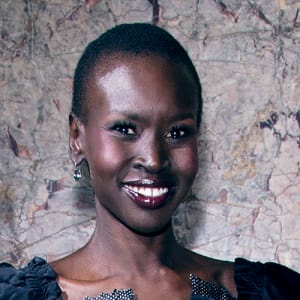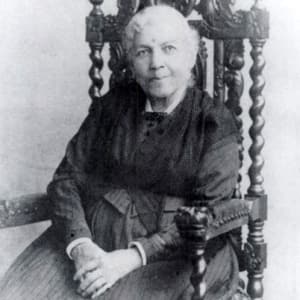
Alek Wek
Alek Wek is a Sudanese-British supermodel who’s famous for being one of the first women in the industry to break conventional beauty standards.
Who Is Alek Wek?
Born in 1977 in South Sudan, Alek Wek was a refugee who, along with her family, fled to the U.K. in the early 1990s to escape civil war. After being discovered at a market in London at 18, Wek's star quickly began to rise in the modeling industry. With her velvety dark skin, high cheekbones and long limbs, Wek became the "IT" model for a new kind of beauty. She began walking for fashion's biggest designers and was the first African model to grace the cover of Elle. With editorials in Vogue and covers for Cosmopolitan, Forbes, Glamour and Ebony, Wek's career has spanned over two decades, shattering mainstream stereotypes of beauty, especially for women of color. Outside of modeling, Alek is also a handbag designer and an activist on behalf of refugees.
Riccardo Sala
Since 2003 Wek was linked to longtime boyfriend Italian real estate developer Riccardo Sala, but the two parted ways in 2013. Although she's admitted that her family has put pressure on her to marry and settle down, Wek continues to stay focused on her professional life, believing she's making a difference.
"I felt that girls growing up needed to see somebody different, who may have been criticized for their nose, or their hair, or anything – that they could be beautiful," she told Marie Claire in 2015. "It’s about telling girls from a young age that it’s OK to be quirky, it’s fine to be shy. You don’t have to go with the crowd."
Net Worth
Wek is reportedly worth $8 million, although other sources have higher estimates.
Early Life
Born on April 16, 1977 in Wau, South Sudan, Alek Wek was the seventh of nine children to mother Akuol and father Athian. Wek's first name means “black spotted cow,” a symbol of luck to her ethnic group, the Dinka.
While Wek's mother tended to the children, her father served as an education official. Sadly, Athian's life was cut short from a hip injury that became infected, and he died in 1985.
That same year, civil war broke out and Wek's family had to escape the warring factions in South Sudan, finding safe passage to the United Kingdom. But life in their new country was difficult for Wek, who was 14 at the time, and barely spoke English.
"It was really, really hard in the beginning," she confessed to The Guardian. "Children at that age can be such bullies. That’s before you even factor in that I looked and sounded so different. But after going through everything, where nothing was ever sure, where I might get killed, I was free…"
Wek eventually enrolled at London's College of Fashion, and it was during her time as a student that she was discovered by a fashion scout at an outdoor market in 1995. Her first big break was appearing in Tina Turner's music video for the James Bond film Golden Eye. After signing with Ford Models in 1996, she appeared in another prominent music video, Janet Jackson's "Got 'Til It's Gone." A year later, she became the first African cover girl in Elle magazine's history.
Modeling
Wek was soon walking the runway for designers like Ralph Lauren, Karl Lagerfeld, Michael Kors, Christian Dior and countless others. Although she was praised for her unconventional beauty, Wek didn't think too much of the flattery. "I didn't see myself as different or exotic," she said when she received attention at her first big show walking for Ralph Lauren. "I'm just Alek, and besides, all women, whether blonde or brunette, are different and beautiful!"
Besides walking the catwalk for the biggest fashion houses, Wek has also appeared on numerous campaigns, including: Clinque, Jean Paul Gaultier, Banana Republic, Saks Fifth Avenue, Gap and Issey Miyake. She's had editorials in both American and British Vogue and has also graced the covers of Elle, Forbes Magazine Africa, Cosmopolitan, Glamour and Ebony.
When she became the first African covergirl for Elle magazine in 1997, Oprah Winfrey interviewed her soon after. "If you were on the cover of a magazine when I was growing up, I would have had a different concept of who I was," said Winfrey.
In 1999 Wek famously posed for a Herb Ritts calendar wearing merely body paint, and in 2001 she made her Victoria Secret debut. A year later, Wek tried her hand at acting, playing a Sudanese princess in the film Four Feathers.
Designer
Wek added "designer" to her resume with the launch of her couture accessories and handbag collection, branded as "Wek 1933." The name is an honor of her father, who was born that year.
Book
After filming a documentary series, Africa Lives (2005), with her mother, in which they set out to find her aunt whom they were separated from during the war, Wek was moved by the experience and decided to share her harrowing journey as a refugee. In 2007 she published her best-selling autobiography, ALEK: From Sudanese Refugee to International Supermodel with Harper Collins.
Activism
Although life as a supermodel has enriched Wek's life, she hasn't forgotten her humble beginnings and has felt compelled to give back to her community and to the world at large. Wek is not only a Good Will Ambassador to The United Nations High Commission for Refugees, but she also serves on the advisory board for the United States Committee for Refugees and is a member of the Congressional Black Caucus for International and Foreign Affairs.
"My father instilled in me a fierce commitment to education," she told CNN in 2012, after visiting South Sudan for the first time since it separated from Sudan in 2011. "As a member of the South Sudanese diaspora, I hope to help continue his legacy."
Wek speaks at schools all over New York City to inform students of the famine plaguing her native country and represents H&M’s Conscious Foundation as a global ambassador.
Wek currently lives in Brooklyn, New York.




